Table of contents
In addition to the dessert banana or fruit banana ( Musa acuminata Colla or Musa × paradisiaca ), which can be eaten raw, there are the cooking banana, which must be cooked before consumption, as well as fiber bananas and ornamental bananas. The peel of the fruit banana is becoming increasingly popular and can even be used in the kitchen.
Use in the kitchen:
What does a banana taste like and are bananas sweet? The riper the banana, the sweeter it tastes and its consistency changes from firm to floury to creamy. When unripe or half-ripe, the banana tastes more like a vegetable that is not particularly aromatic. It has a furry feeling in the mouth.
Bananas are an ideal snack and can be enjoyed raw on the go thanks to their peel. Along with apples, bananas are one of the most commonly consumed fruits. They are popular in smoothies , muesli, milkshakes (frappé) and all kinds of dessert variations - whether pure with (soy) yoghurt or quark, in fruit salad,dried as banana chips , baked in batter or as banana splits, even as cakes (banana chocolate cake, tart), pancakes, cakes and muffins. They are also popular in banana bread and as a vegan egg substitute in other baked goods.
Banana powder made from dehydrated bananas is also very suitable for enriching the flavor of shakes and smoothies.
Those who like to experiment use bananas in spicy curry dishes. The best option is to use green dessert bananas, which can be cooked well due to their high starch content. Their taste is very reminiscent of sweet potatoes . On the island of Zanzibar, cooked green fruit bananas are a popular dish. 1
You can use the banana leaves to wrap food. The peel of untreated organic bananas can be boiled, fried or baked and eaten, used as an ingredient in smoothies or brewed as tea. The peel of very ripe bananas is particularly suitable for eating raw, as it is then significantly thinner and sweeter and easier to chew.
The banana is a component of the gluten-free and raw vegan Erb-Müesli . It contains citrus fruits rich in vitamin C as well as berries that provide antioxidants, pseudocereals, seeds and golden millet . Also try the Erb-Müesli plus oat flakes variant.
The so-called cooking bananas (vegetable bananas, flour bananas) are (practically) only edible when cooked. They and their flour are a staple food in many African countries. There is also the red fruit banana, which tastes a little sweeter and more aromatic than the yellow Cavendish banana. This also applies to the baby banana, which is around 10 cm long.
Vegan recipe for quick chocolate peanut ice cream:
Cut 4 peeled, ripe bananas into pieces and freeze at least overnight. Puree with 1-2 tablespoons of cocoa powder (depending on taste) and 1-2 tablespoons of crunchy peanut butter to make creamy ice cream. Add a little soy milk if necessary. The ice cream should be eaten fresh; if refrozen, it loses its creamy consistency.
Vegan recipe for banana bread:
First, mix 300 g wholemeal spelt flour with 100 g whole cane sugar (sugar), 10 g baking powder and a pinch of salt . Add 3 pureed bananas, 100 ml coconut oil and a dash of soy milk and stir. Season with a little cinnamon and fold in a handful of chopped walnuts . Bake in a greased loaf pan in the oven at 180 °C for around 50 minutes. Coconut oil is quite unhealthy - see this link - but this can be an exception. You can find more vegan banana recipes here. There are also banana tiramisu or flambéed bananas, banana oatmeal cookies, etc.
| Not only vegans or vegetarians should read this: Vegans often eat unhealthily. Avoidable nutritional mistakes . |
Shopping - where to buy?
Bananas are one of the most popular and most purchased fruits. They are available in bunches, which are botanically known as "hands", or individually in all well-known supermarkets and discount stores such as Coop , Migros , Denner , Volg , Spar , Aldi , Lidl , Rewe , Edeka or Hofer . Bananas can also be bought in organic supermarkets such as Denns or Alnatura, as well as in health food stores, smaller organic shops or at the local weekly market. They can also be purchased via a subscription box (Green Box) or online. If you choose the latter, you have the option of getting bananas that have been collected in the wild.
Because they are grown in countries near the equator, bananas are in season all year round .
When buying bananas, they should be free of bruises. You should also make sure that the bananas do not look greyish. This suggests that they have been stored at temperatures that are too cold, which hinders natural ripening. To avoid high levels of pesticide contamination in bananas, you should go for organic quality. From an ethical point of view, bananas with a Fairtrade seal are recommended, which guarantees good working conditions during cultivation.
Where do the bananas in Germany come from? The goods available in Germany mainly come from Ecuador, Colombia, Panama and Costa Rica. They are mostly Cavendish varieties, which account for over 40 percent of global production and practically all exports. 2,3
Found in the wild:
In countries where bananas are grown for export, the plants often grow wild. 1
The actual wild bananas include the species Musa balbisiana and Musa acuminata , which originally come from tropical Southeast Asia. Wild bananas are small, green and contain many large, infertile seeds that are comparable to the seeds of the prickly pear . 4
Storage:
Store green or yellow-green bananas in the shade and at a lower room temperature. Bananas should never be stored in the refrigerator. Bananas need more than 13 °C. They will ripen in a few days. To avoid bruising, you can hang bananas on a hook or a so-called banana tree. In any case, you should remove plastic packaging. The fruit will quickly rot in plastic packaging.
If you want to speed up the ripening process, you can store bananas together with an apple in a paper bag. The apple gives off ethylene gas, which makes the banana ripen faster. This also works with tomatoes or other ripe bananas. Putting them together with unripe fruit speeds up their ripening, while the ripe banana does not overripe as quickly.
Bananas are sweetest when the skin gets brown spots. Bananas that are this ripe can be stored in the fridge for a few days. The cold temperature can cause the skin to turn dark, but it remains firm and the taste remains the same. Bananas can also be kept in the freezer for several months. However, you should definitely peel them before freezing, as this is difficult to do later. If you sprinkle them with a little lemon juice , they will retain their fresh color even when thawed.
Ingredients - nutritional value - calories:
Bananas are considered a particularly valuable source of potassium with 358 mg/100g. However, various dried legumes have significantly higher levels with up to 1,797 mg/100g, followed by unpeeled hemp seeds (1,200 mg), raw wheat germ (892 mg) or sultanas (746 mg). Compared to other types of fruit, however, bananas contain relatively high levels of potassium. 5
Bananas are known for their content of B vitamins, especially vitamin B 6 (0.37 mg/100g). Vitamin B 6 is involved in around 100 enzymatic reactions and plays an important role in protein and blood sugar metabolism. Raw rice bran, with 4,070 mg, provides many times more vitamin B 6 than bananas, as do pistachios (1,700 mg), wheat bran (1,303 mg), sesame (0.79 mg) and wholegrain rice (0.736 mg). 5
Bananas are also praised as a good source of magnesium , but the value of 27 mg/100g is exceeded by many other foods: rice bran (781 mg), unpeeled hemp seeds (700 mg), wheat bran (611 mg), sesame seeds (351 mg) or chia seeds (335 mg). 5
Are bananas fattening? Bananas are a recommended food in a balanced diet. In addition to a balanced mixture of carbohydrates with water-soluble and water-insoluble fiber, bananas contain very little fat. 5 However, nerves and the brain (brain) need high-quality, monounsaturated and polyunsaturated fatty acids , which need to be compensated for.
The nutritious banana with its 89 kcal/100g 5 has been a popular superfood in the western world for many years. It provides quick energy and valuable nutrients. Nevertheless, the term superfood means little, as it mainly serves marketing purposes and is used for a variety of foods.
Detailed information on the nutrients can be found in the tables below. These show, for example, the percentage coverage of the daily requirement.
Health aspects - effects:
How healthy is a banana? Half-ripe bananas contain a proportion of indigestible resistant starch. The positive effects of resistant starch are well known. Since the small intestine cannot digest and absorb resistant starch or can only partially digest it, bacteria ferment the fiber in the large intestine and thus promote a healthy intestinal flora, protect the intestinal wall from cell changes and support its barrier function. Resistant starch also has a blood sugar regulating effect. You can rest assured that you will absorb sufficient resistant starch if you eat a balanced diet with whole grain products, pulses and also bananas. 6
Ripe bananas can have a calming effect on stomach and intestinal disorders and are also suitable for small children. The soluble and insoluble fiber helps regulate digestion and cholesterol levels. 2 Various specialist bodies recommend ripe bananas for intestinal inflammation.
A scientific study at Jacobs University Bremen led by chemistry professor Nikolai Kuhnert investigated the healing power of (wild) bananas. They contain many polyphenolic, i.e. aromatic compounds that have antibacterial, disinfectant and astringent (contracting) effects. Bananas can therefore help protect a wound from bacterial infections or form a kind of protective layer over a wound by changing the protein in the wound. 7
Dangers - Intolerances - Side effects:
Eating green, unripe bananas can lead to stomach pain, as the intestines cannot process the high cellulose content. 1 But even ripe bananas can cause flatulence if you have a sensitive gastrointestinal tract or if you eat them infrequently, as they are one of the fruits that cause severe flatulence.
Use as a medicinal plant:
In parts of Africa and Asia, wild bananas ( Musa acuminata ) are considered a traditional remedy. However, the Cavendish banana, which is available in European supermarkets, is not believed to have any healing powers. In many developing countries, open wounds are covered with banana leaves or banana peels. Even larger wounds can be treated successfully in this way. 7
Occurrence - Origin:
The banana originally comes from the Southeast Asian islands. Scientists suspect that the domestication of bananas began 7,000 years ago. 1,4 The first written mentions can be found in Buddhist and Indian writings around 600 BC. From Indonesia, the banana reached Madagascar and then the African mainland. The Spanish cultivated banana plantations on the Canary Islands from around 1500. Not much later, the banana came to America, where Portuguese settlers established the first plantations in the Caribbean and Central America. 1
Today, bananas grow in tropical and subtropical regions, in the so-called banana belt, which is located around the 30th parallel. 1
According to figures from Wikipedia, world production in 2000 was 67.2 million tons, and in 2017 it was about 114 million tons. The world's largest producer was India with 30.5 million tons. The main export countries in 2016 were Ecuador, Costa Rica, Guatemala, Colombia and the Philippines, and the main importers worldwide were Europe and the USA. 1
Growing in the garden or as a potted plant:
Basically, bananas need enough sun, warmth, nutrients and consistent watering, although waterlogging and direct sunlight should be avoided. During the growing season from May to August, the plants should be fertilized weekly with a nitrogen-rich complete fertilizer. 9 If the banana plant loses leaves, this is a clear sign that it is too cold, too wet or too dark. 8
In Central Europe, banana plants can be grown as pots or winter garden plants, whereby the pot should hold at least 50 l. Fruit-bearing dwarf varieties such as "Dwarf Cavendish" or "Ladyfinger" are suitable for this. In winter, the winter garden should be heated and at least 10 °C. In cooler winter gardens, the banana leaves are cut off and placed on the soil around the plant to protect them. 9
In very mild regions, it is even possible to cultivate banana plants outdoors permanently with suitable winter protection. The relatively hardy Japanese fiber banana Musa basjoo (-3 °C) does not manage to produce flowers or fruit due to the average temperatures being too cool, but it does spread a tropical flair in the garden. The currently hardiest varieties of Musa basjoo are "Nana" and "Saporro", which are characterized by improved frost resistance (down to -12 °C). In autumn, the leaves are cut off so that the rhizome can store enough nutrients for the winter. A 50 to 100 cm high casing is built around the plant and filled with insulating material such as garden fleece, jute or raffia mats. A waterproof plate protects the plant from waterlogging. 8.9
Cultivation - Harvest:
Bananas are mainly grown in monocultures on plantations for export. Intensive farming and the use of pesticides, which are banned in Western countries, lead to ecological damage in the growing regions and to health problems for employees. Organic farming relies on mixed crops and the use of chemical-synthetic pesticides is not permitted. 1
How often does a banana bear fruit? Banana plants usually grow on plantations for two years, but only bear fruit once. The plants generally need a lot of water.
What type of fruit is the banana? Within three months, three to five-edged, 6 to 30 centimetres long and 2 to 5 centimetres thick berries develop from the female flowers without fertilisation. The entire fruit of the banana plant is called a "bunch" (or arm), which can contain up to 300 bananas and weigh up to 50 kg. The individual bananas, so-called "fingers", are arranged in "hands" and are arranged in a spiral around the inflorescence axis. Each individual fruit initially grows downwards and later, due to the effect of plant hormones, outwards and upwards within a few days. 1,3
How tall can a banana tree grow? The green bananas are harvested with a large hooked knife. The entire fruit is cut off from the 2 to 9 m high plant and transported, sometimes using simple material cable cars, to the packing station. There the fruit is divided into so-called "hands" or "finger tufts", the size offered in retail stores. 1 The export bananas reach their destination in temperature-controlled refrigerated ships at exactly 13.2 °C. There the bananas are stored in special ripening chambers with the addition of the ripening gas ethylene. 3
Animal protection - species protection - animal welfare:
In contrast to ornamental and wild bananas, cultivated fruit bananas are sterile. The fruits of fruit bananas develop without pollination and fertilization. Cultivated bananas are seedless, which is why neither generative reproduction nor cross-breeding is possible. Most banana varieties are propagated purely vegetatively from the runners that sprout from the underground rhizomes. 1
In their original distribution area, pollination of banana flowers on wild banana plants takes place through hummingbirds and bats. 8
General information:
The dessert banana ( Musa acuminata Colla or Musa × paradisiaca ) is a species in the banana genus ( Musa ) and belongs to the banana family (Musaceae).
The group of dessert bananas can be divided into "large fruit bananas", "red bananas", "baby bananas" and "apple bananas", each with several varieties. Well-known varieties of large fruit bananas are "Robusta", "Williams", "Poyo", "Valery" - the giant of the Cavendish group, "Dwarf Cavendish" - a small and very tasty variety - and "Grand Nain" or "Grande Naine", the main export variety in Latin America. 3.10
In addition to dessert bananas, cooking bananas, flour bananas and vegetable bananas, which mainly come from Africa, are also referred to as Musa × paradisiaca . In total, there are around 70 types of banana and over 1,000 hybrids and variants of cultivated bananas. 1 International breeders are constantly driving forward the development of new varieties in order to breed suitable varieties that are resistant to the widespread fungal disease "Yellow Sigatoka" ( Mycosphaerella musicola ) or "Black Leaf Measles" ( Mycosphaerella fijiensis , Black Sigatoka). 4
The wild bananas Musa acuminata and Musa balbisiana, originally from Asia, are separate plant species from the banana genus ( Musa ). Almost all modern varieties of edible bananas are hybrids and polyploids of these banana species, which are usually referred to as Musa x paradisiaca or Musa acuminata Colla. The most commonly exported variety, "Cavendish", is a triploid mutant and "Lady Finger" is a diploid variety of Musa acuminata . 11,12
Do you want to know how exotic it was to switch from conventional banana cultivation to organic in the early 1980s? Read our text "First organic bananas from Tenerife, the 20 banana letters" .
Alternative names:
Alternative names for the dessert banana are fruit banana, large fruit banana, paradise fig, Adam's fig or simply banana.
The English name is banana.
Keywords for use:
The fiber or textile banana Abacá ( Musa textilis ), also known as Manila hemp, banana hemp or Musa hemp, is used to produce nets, ropes and yarns. But bananas are not only popular as crops, but also as ornamental plants. A well-known banana species with improved frost resistance is the Japanese fiber banana ( Musa basjoo ). 10
Literature - Sources:
Bibliography - 12 Sources
| 1. | wikipedia.org Dessertbananen. |
| 2. | bzfe.de (Bundeszentrum für Ernährung). Die Banane. Exotische Beere mit vielen Eigenschaften. |
| 3. | aid Infodienst (Herausgeber). Exoten und Zitrusfrüchte. 4. Auflage. Bonn;2014. Druckerei Lokay e. K. Reinheim. |
| 4. | plantura.garden Ur-Gemüse und Ur-Obst im Wandel der Zeit. |
| 5. | USDA (United States Department of Agriculture). Nährstofftabellen. |
| 6. | ugb.de (Unabhängige Gesundheitsberatung). Resistente Stärke: Bedeutung unterschätzt? |
| 7. | medizin-und-technik.industrie.de Wundversorgung. Bananenschale ersetzt Pflaster. |
| 8. | plantura.garden Bananenpflanze im eigenen Garten pflanzen & pflegen. |
| 9. | lubera.com So gelingt die Bananenpflanzen Pflege. |
| 10. | wikipedia.org Bananen. |
| 11. | wikipedia.org Musa acuminata. |
| 12. | wikipedia.org List of banana cultivars. |

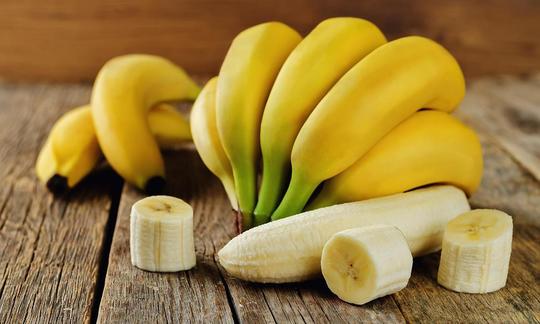

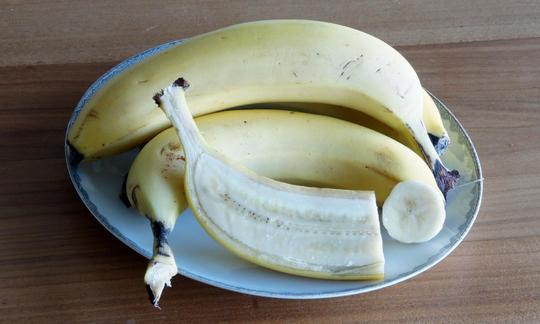

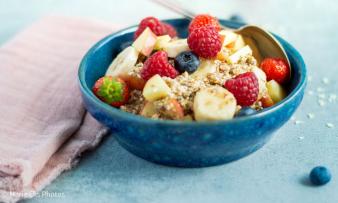
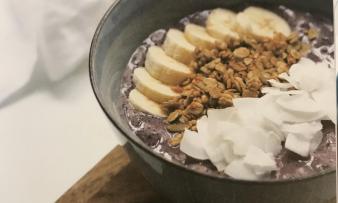
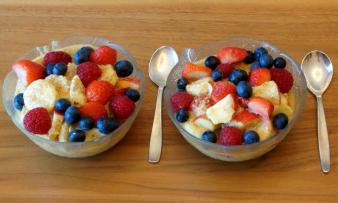





Comments